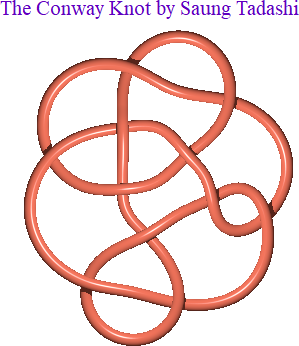
Solve and submit the following problems.
Problem 1.

Problem 2. Rather than fixing the Kauffman bracket by using a writhe counter-term, it is tempting to evaluate it at $A=e^{\pi i/3}$, where invariance under R1 holds with no need for a correction. Unfortunately, at $A=e^{\pi i/3}$ the Kauffman bracket of any knot is equal to 1. Prove this.
Problem 3. Prove that the PD notation of a knot diagram determines it as a diagram in $S^2$. (This one is tough. Don't feel too bad if you don't succeed).
Problem 4. Use the programs we wrote in class to compute the Jones polynomial of the Conway Knot:

Due date. This assignment is due on Monday July 3 at 11:59pm. Submission is on Google Classroom.